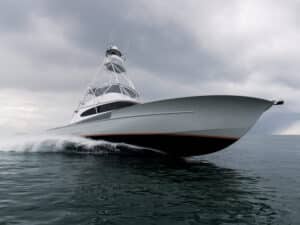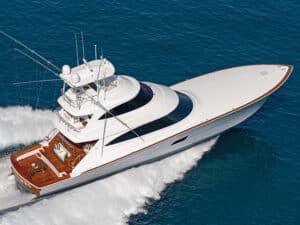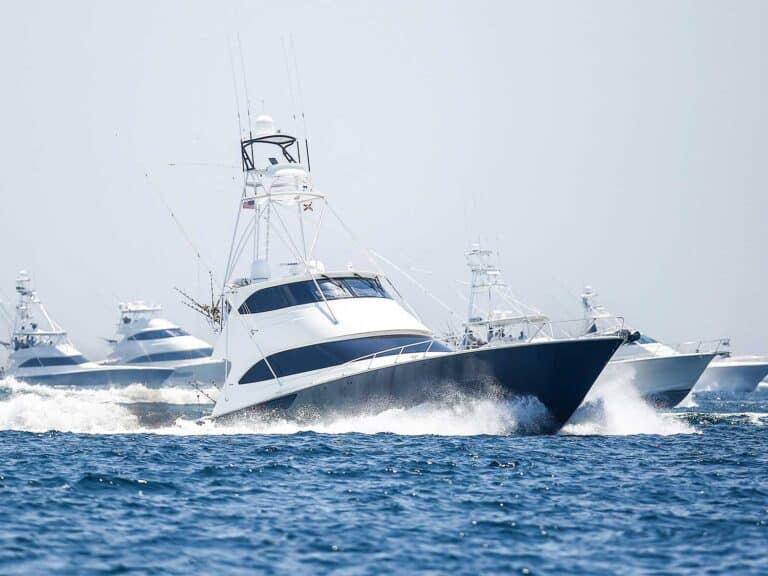
I remember the first Paul Mann boat I ever laid eyes on: She effortlessly skated by me, seemingly in slow motion. There was just something about her sweeping stem, that perfectly placed house, those teardrop-shaped windows and that unforgettable, not-too-much Carolina flare that I couldn’t get enough of. And every single one rolling out of Manns Harbor, North Carolina, just keeps getting better. The new Full Time is no exception; as a matter of fact, she may be the rule.
Working alongside esteemed naval architect Robert Ullberg on their fifth collaboration, builder Paul Mann ensured the owner’s dreams were brought to life, with all the criterion Mann boats are known for: toughness, speed, handling and performance.
Full Time is designed for family travel, taking just 32 months, start to finish. By taking into consideration the needs of her owners—adults and kids alike—the result is clean and classy. Mann personally delivers a product “as turn-key as possible,” he says, where every owner and captain gets a hands-on, as-long-as-it-takes tutorial by Mann himself so, “no time is wasted ‘learning’ the boat —they can go straight to using it,” he says.
Hull and Superstructure Construction
For 30 years, Mann has been perfecting his boatbuilding techniques. Each one of his builds is a true Carolina hull—with no overexaggerated flare or tumblehome—and the 77 is no different. Using the latest in sophisticated materials, technology and processes, traditional cold-molded jig construction combined with lighter composite materials such as Divinycell foam core are the building blocks to a create a hull that is not only seaworthy, but lighter than other typical 70-plus-footers.
The hull is comprised of three layers of 1/4-inch Okoume plywood with one layer of 1.5-ounce fiberglass mat between each. The hull bottom and bow deck are reinforced using the same method, but with four layers of 1/2-inch Okoume. This wood/glass layering technique ensures additional strength and creates a barrier to avoid water intrusion should the hull be compromised or punctured. Smart.
Douglas clear fir stringers are glassed in place and the inside of the hull is lined with 1-inch Divinycell. The entire hull structure is then glassed, inside and out; the superstructure—cabin, house and bridge—is fabricated of weight-saving Divinycell, which is also glassed and faired.
Performance
Despite the pouring rain on the morning of our review, I just had to walk the length of Full Time at the dock. She is massive, and the Awlgrip Cloud White hull was faired to perfection and sparkling in the low light.
The short idle to the bay showed little wake for such a large footprint, and just as the rain started to clear, we were up and running. Timing is everything.
With a 12-second hole shot, we were soon cruising along at a swift 38 knots at an 80 percent load with the boat half-full. The boat’s ability to make multiple tight circles at speed with no shuddering proves the running gear perfectly suits this 77-footer to a T.
At lure speed, the wake was relatively clean despite the large, five-blade Veem propellers. Planing out at just 12 knots, a mere 25 feet separated the whitewater from the clean lanes. And as we began the backing down phase of the sea trial, very little water seeped through the transom door and no vibration was noticeable.
Ninety-seven percent load to wide open showed speeds upwards of 44 knots, burning 135 gallons of fuel per side, even in the stiff side wind. And the ride? It was every bit Paul Mann.

Interior
As I entered the salon, the 8-foot headroom is almost cavernous. Immediately to starboard is a day head fitted with a small sink bowl, painstakingly carved from a single block of teakwood and fitted to a solid teak vanity top. To port, a large U-shaped couch with lift-up storage in a taupe shade of pewter surrounds the main area, opposite a teak cabinet that houses the pop-up TV and entertainment system, bar accessories and ice machine. Custom-built teak soffits wrap the salon in chilled-water air-conditioned comfort, and the blindless SmartTinted windows are individually framed in 4 inches of seamless, solid teak.
Hand-selected satin veneers cover the cabinet faces throughout and come from a single teak log—book-matched ceiling to floor—and each cabinet top is solid and slightly bull-nosed. The galley tops are fitted with teak sea rails that rim white Calacatta quartz countertops.

The 2 1/2-inch planked floors in the galley, dinette and pantry—which also houses a coffee bar, two Sub-Zeros and a wine cooler—as well as the master stateroom and master head are all laid on the horizontal line and were constructed from one piece of teak, with no seams or joinery.
The 4-stateroom/3-head layout screams generous. Instead of opting for a ridiculously large master, the owner kept his portside stateroom modest, insisting that every room be comfortable. And there is not a bed on the boat that is shorter than 7 feet or less than 38 inches wide.
Forward of the three-bed crew room, the VIP is arranged bunk-style, with a full above and queen below. All the way forward you will find the “kids’ room” complete with a private head and all the necessary electronics to keep them entertained. Styled for the owner’s children, each one of the four equally sized bunks fit longitudinally in the forepeak.
The entire interior is mod-sharp, displaying shades of not only golden teak, but greys, various whites, taupes and dark blues, and each of the three heads have large showers and the same white quartz countertops. And if you thought it couldn’t get any better, Full Time offers more storage than you could imagine, including a 12-foot-long forward bilge that flaunts 4 feet of headroom.

Cockpit and Bridge
If not outside, you’d think you stepped into an Old World library. The hatchless teak deck is stunning, but the varnished mezzanine and rich bulkhead is the star. Stout teak offsets the feminine cockpit curves for a look that is thoughtful and balanced.
Rod lockers and access doors on either side provide storage and cover shore and electrical connections; the lounge is dressed in Storm Grey Silvertex with air-conditioning vents that flow unobstructed. The cockpit hardware is kept to a minimum, with only the large, Euro-style cleats, boltless rod holder caps, corner hawse pipes and custom deck drains shown, keeping the clean and classy feel going.
Freezers span the length of the mezzanine step and the deep Eskimo ice bin is located under the starboard-side jump seat. “You’ve got to be able to get to things,” Mann says, implying every inch of usable space must be carefully thought out for both practicality and convenience.
The bridge is laid out in a center-console design with a helm station that is elevated by a teak-decked platform. Three Garmin GPSMAP 8617 multifunction displays are cleanly mounted, with all other electronics installed in two boxes on either side of the teak helm pod.
With varnished teak end tables and tops, a U-shaped lounge wraps the perimeter of the bridge deck. A club chair is molded to the front of the helm with teak arm rests and a lift-up coffee table laid on the centerline, truly bringing the indoors out.

Engine Room
Through the deck hatch by the salon door, you step onto a solid threshold and down to the engine room—seemingly shining on its own with more than 6 feet of headroom. Forward and through a watertight sub door, the massive MTU 2600s take their place on an engine bed that is a mechanic’s dream. Accessibility is the blueprint of this engine room, where every system and every item has its place.
Two Northern Lights 38-kW gensets occupy the aft bulkhead and clever shelving combined with battery boxes line both sides outboard the engines. On the fronts of the boxes you find the applicable switches, breakers and fuses for all systems requiring battery power. On the forward bulkhead, overhead cabinets keep filters and other necessities organized and off the sole, while two Mitsubishi MSM-2500T-A1 gyros keep the vessel on even keel—and system redundancy does not fall short.
Read Our Review of the Paul Mann 61, Jichi here.
Beyond the aft bulkhead, a corridor between two of three fuel tanks—holding 1,058 gallons each—lead to the lazarette where steering components, livewell hoses, common drains and wiring are all deliberately managed and accessible.
“Full Time is a definite home run for me,” Mann says. “It turned out better than I could ever have expected on many, many levels.”
The old teardrop windows may have gone by the wayside, but the time-honored North Carolina custom quality remains. And if you weren’t already, Full Time will make you a Paul Mann fan—just like me.










